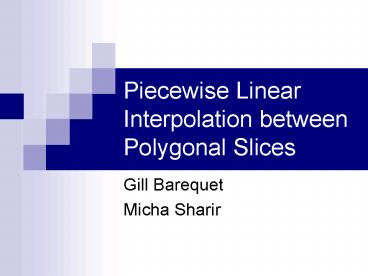Piecewise Linear Interpolation between Polygonal Slices - PowerPoint PPT Presentation
1 / 20
Title:
Piecewise Linear Interpolation between Polygonal Slices
Description:
Stitch. Triangulate the rest. Orientation ... Choose arbitrary one end to start the stitching from. ... Stitching and summing (2) After summing we remain with ... – PowerPoint PPT presentation
Number of Views:119
Avg rating:3.0/5.0
Title: Piecewise Linear Interpolation between Polygonal Slices
1
Piecewise Linear Interpolation between Polygonal
Slices
- Gill Barequet
- Micha Sharir
2
Reconstruction from Polygonal Slices
- Input series of parallel planar slices not
crossing but might be nested. - Output Polyhedral solid model whose
cross-sections along the given planes coincide
with the input slices.
3
Wish List
- No input limitations.
- Automatic procedure.
- intuitive surface.
4
The Algorithm in Brief
- Match similarities
- Stitch
- Triangulate the rest
5
Orientation
- Orient all contours in each slice in alternating
directions, from the outside to the inside,
Starting clockwise.
6
Discretize
- Discretize each contour polygon into a cyclic
sequence of vertices with a constant and small
(enough) length.
7
Finding similarities Voting process (1)
- The voting process is done for every pair of
contour polygons which belong to a different
slices. - Indexing The two cyclic contours are break into
two linear indexed vertices list. - For each vertex C2(j) with distance less then e
from vertex C1(i) we place a vote for (j-i)(mod
lc2). - Large number of votes reflects long portions of
contour matching. - Identify the start and end of each match.
8
Finding similarities Voting process (2)
- Score each match according to the number of votes
and additional parameters (Distance, max.
consecutive mismatch). - Notes
- e is an a-priory estimation of the physical
differences between two slices. - The distance function considers orientation. This
guarantees that the material will be on the same
side of the contours. - Its most important that every intersected pair of
contours will be matched.
9
Stitching
- We stitch all the pairs vertices chains which
were discovered. - Stitching algorithm
- Inverse the orientation of lower chain.
- Choose arbitrary one end to start the stitching
from. - Always add the triangle with the shorter
perimeter.
10
Stitching and summing (1)
- Inversing orientation
- Stitching
- Summing (e (-e) 0)
11
Stitching and summing (2)
- After summing we remain with 3D polygon (Clefts)
- When projected to xy-plane Clefts are
non-intersecting. This is due to the matching in
the interesting neighborhood. - The Clefts form an hierarchy of nested curves
when projected to xy-plane.
12
Connecting the Clefts
- Build a complete graph with vertices represent
Clefts and edges represent the minimum distance
between the two Clefts. - Calculate Minimum Spanning Tree.
- Build Bridges According to the MST ? simple 3D
cycle (also a cycle when projected to xy-plane). - Triangulate Using dynamic programming function
which minimize a given function (e.g area or
perimiter).
13
Example (1)
14
Example (2)
15
Conclusions (1)
- The algorithm overcomes the classic problems
nesting and branching. - The algorithm doesnt take any assumption on
input. - The procedure is automatic except for few
parameters (discretize length, e distance hard
decision parameter and cost function of the
Clefts triangulation). - The algorithm enforces that planer intersecting
contours will be connected, and for a reasonable
e non nested or intersecting contours wont be
connected.
16
Conclusions (2)
- The algorithm divide the solution to a set of
simple known algorithms and therefore
implementation should be simple as well. - The authors claim to test the algorithm on
several examples including synthetic contours,
real contours (CT,MRI) and cases taken from
previous works (boissonat and unsolvable
problems of gitlin, ORouke and subramanian). The
Algorithms gave good results with all of those
examples. However, only few examples are given in
the paper.
17
Conclusions (3)
- Its not proven in the article that bridges wont
cross contours and Cleft projection is a simple
circle. The authors does refer to this problem as
unlikely to happen if using sufficiently good
parameters. - The paper is written clearly and is
self-contained. More and better examples would
make it simpler to understand.
18
Bonus example (1)
19
Bonus example (2)
20
Bonus example (3)































